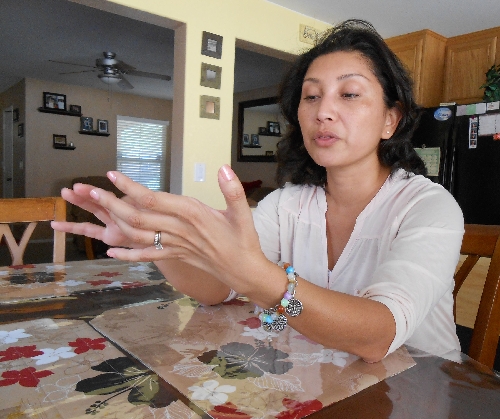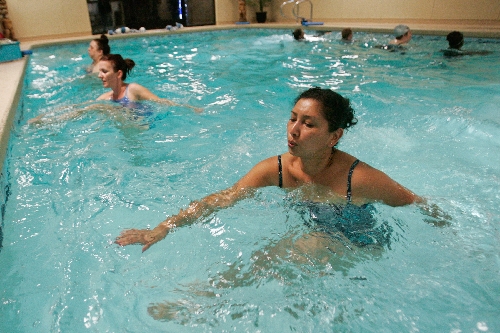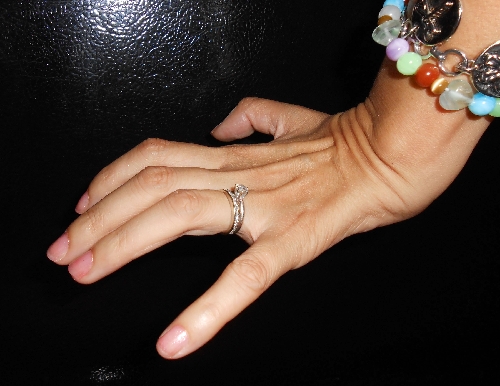Support group looks to help those with Charcot-Marie-Tooth disease
CMT is not just a country music station. It also is the acronym for Charcot-Marie-Tooth disease, which doesn't have anything to do with charcoal or dental issues.
Northwest Las Vegas resident Virginia Mamone, 39, knows CMT all too well. Because of the confusing name, she tells people it is a neuromuscular disorder. She has had it for roughly 15 years. It began as a tingling in both of her little fingers.
"Then it was things like (difficulty) opening jars, opening cosmetics, and I have a hard time with buttons ... and washing dishes, holding anything wet, I'll drop it," she said. "We've had plenty of cups and glasses broken, and it's all (because of) me."
Her doctor thought she might have a pinched nerve. But other symptoms appeared ---- her hands would inexplicably clench, she'd have leg pain each night, and fatigue could hit at a moment's notice. Then her leg muscles began to noticeably shrink, and she began having nightly leg cramps.
"You feel like a freak," she said. "Like, I used to wear shorts, but people stare at you because they see the atrophy of your legs, and you try to hide."
As each symptom appeared or worsened, doctors still had no solid explanation. One day, six months after giving birth to her daughter, Mamone was carrying the infant to bed when the big toe on her left foot suddenly curled under and caused her to trip. Luckily she was near her bed, and she was able to plop the infant onto it, unharmed.
It was a wake-up call. She had to get to the root of this.
A series of tests followed ---- an MRI, electric nerve conduction tests and a spinal tap. Each test was more intense, and each shed no light on what was causing her symptoms. Mamone's husband, Nick, held her hand when the aftereffects of the tests sent her to the emergency room.
"He's my rock," she said.
Finally, about four years ago, she went to the University of California, Los Angeles Medical Center for DNA testing. Within a month, she learned she had a genetic marker for CMT, which is an inherited disorder. Suddenly things made sense, such as how her aunt Angelia was told she had polio even though she didn't truly fit the pattern. Then there was the photo that showed her great-grandmother Mercedes with torturously clenched hands.
But doctors could offer her no treatments. So, armed with the diagnosis, Mamone hit the Internet and found out all she could.
According to the National Institute of Neurological Disorders and Stroke, CMT affects about 1 in 3,300 people. The disease affects the nerves outside the brain and spine and the peripheral nerves, destroying the covering around nerve fibers, called the myelin sheath. The nerves tasked with movement are most severely affected. Usually the nerves in the legs are targeted first and the most severely.
Symptoms usually show up between mid-childhood and early adulthood and often include foot deformity (very high arch to feet; foot drop, meaning inability to hold the foot horizontal); loss of lower leg muscle, which leads to skinny calves; numbness in the foot or leg; a "slapping" gait, meaning the feet hit the floor hard when walking; and weakness in one's hips, legs or feet.
As the disease progresses, similar symptoms are likely to appear in the arms and hands, often including a claw-like hand.
Two of Mamone's three children also carry the gene.
"That was the worst," she said. "For a long time I felt very guilty that I had given this to my kids. I cried for a long time."
Her 15-year-old son took the news especially hard. They cried together, and she told him that he wasn't alone, and that no matter what, they'd tackle this together.
Part of tackling it was being outfitted with leg braces and doing special exercises. Both of them are now intent on slowing further deterioration.
"It's a disability," she said, "but you can't stop us."
Though the disorder is chronic and progressive, she aims to slow further damage with physical therapy, yoga and water aerobics.
She's made it her mission to educate people. To that end, she's become co-facilitator for a support group that meets about every two months. About 25 families who are affected by CMT attend.
The next one is planned for 10 a.m. to 1 p.m. Saturday at Community Lutheran Church, 3720 E. Tropicana Ave. It is free and open to the public.
Jerry Cross, the other facilitator, lives in Pahrump. He is one of seven siblings with CMT. Two of his three daughters have CMT, as do three of his six grandchildren. He said his biggest concern is his grandchildren.
"My one grandson had to have both feet surgically worked on," he said. "(The feet) were curling and twisting, so they had to go in and break the bones and fuse them together and use staples and stuff."
Cross sets up a booth at any fair, car show or event he can to help spread awareness and raise funds for research. He said it was frustrating to see a physician or physical therapist and mention his condition, only to see a stumped look on his face.
"So, whenever we go to a doctor, we take along a pamphlet explaining what CMT is," he said. "It's sad, it really is sad ... that you've got to teach them, so that they can help you."
CMT research often benefits from Lou Gehrig's disease, multiple sclerosis and Alzheimer's disease clinical trials, which are ongoing across the nation. Adult stem cells are also being explored for a possible solution. Cross said he expects some sort of treatment to debut in about five years.
As for Mamone, she has pinned her hopes on the research.
"Even if it's too late for me, I want to see a cure for my kids," she said. "I picture a world without this in it."
Contact Summerlin/Summerlin South View reporter Jan Hogan at jhogan@viewnews.com or 702-387-2949.
Charcot-Marie-Tooth disease support group
The Charcot-Marie-Tooth disease support group plans to meet from 10 a.m. to 1 p.m. Saturday at Community Lutheran Church, 3720 E. Tropicana Ave. Guest speakers are planned.
Meetings are planned in 2013 for Feb. 2, April 6, June 1, Aug. 3 and Oct. 5.
For more information, call 775-751-9634 or 702-343-3572.




















